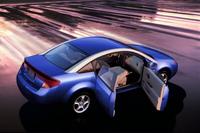Review: 2003 Saturn Ion 3
SEE ALSO: Saturn Buyer's Guide
THE AUTO PAGE By JOHN HEILIG
SPECIFICATIONS
MODEL: Saturn Ion 3
ENGINE: 2.2-liter Ecotec inline 4
HORSEPOWER/TORQUE: 137 hp @ 5,600 rpm/142 lb-ft @ 4,200 rpm
TRANSMISSION: 5-speed manual
WHEELBASE: 103.2 in.
LENGTH x WIDTH x HEIGHT: 184.5 x 67.2 x 57.4 in.
STICKER PRICE: $16,875
Saturn's success has been built on two pillars; great customer service and a solid design. For years, the GM division got by with a pair of car lines, the S-Series (for small car) and the L-Series (for large car - in Saturn terms). Both were good, solid designs that offered decent value. But the small menu was getting stale and, like McDonald's, Saturn decided to add to the offerings. The first new item was the Vue sport utility vehicle, which is a compact SUV offering good product attributes.
The second new offering actually replaces the S-Series, and that's the Ion. When Saturn first announced the Ion at the 2002 New York Auto Show they had a lot of fun with the name. "Keep your Ion Saturn," was one of the cues they played with successfully. Needless to say, the Ion is a solid well-balanced car with a lot of positive attributes.
The Ion is recognizable on the highway by its unique design. Unlike the S cars of old, the Ion has an even more aerodynamic profile with a tail that is reminiscent of the Nissan Altima or Chrysler 300M. With arching roof rails ("McDonald's arches") that can be ordered in a color contrasting to the body color, the effect is also like an elongated VW New Beetle. In any case, you'll like the looks of the Ion.
An auto writer friend of mine absolutely hated the old Saturn design, but was very much in favor of the new Ion, so at least one cynic was converted.
My big complaint about the original Saturn was the buzziness of the four-cylinder engine, so I was interested to see what was going to power the Ion. Under the hood is GM's new small engine, a 2.2-liter Ecotec four that pumps out 137 horsepower and isn't buzzy. We've had the opportunity to drive cars with this engine before, especially the Chevrolet Cavalier, and have liked both its performance and economy. I'm noted for complaining about underpowered cars, but I felt that the Ion's Ecotec four was a good match for the sedan. Since the car weighs under 3,000 pounds, not a lot of power is required to get it going and keep it at a decent speed on highways. When you're behind the wheel of an Ion you know you're not behind the wheel of a Corvette, so slightly lower performance is acceptable.
The engine is connected to a five-speed manual gearbox that may be part of the reason for fewer power complaints. I like manual gearboxes in small engined cars because it permits the driver to take full advantage of the engine whenever possible. A CVT constant variable automatic is available in the coupe, and a five-speed automatic is available in both models.
We talked about exterior design, which is excellent. Inside, there's another story altogether. Saturn must have designs on marketing the Ion in right-hand drive countries, because the instrument cluster is in a pod located over the middle of the dash, much like the Mini. This is a bit disconcerting at first, because when you look down to see how fast you're going, there's no speedometer in front of you. It takes an extra tick of time to look to the right. Once you become accustomed to the instrument location, there's no big problem. The instruments are actually higher than other cars and it simple requires a shift to the right to check your speed and then back to the road.
But in the beginning, it's a challenge. The relocated instrument cluster also allows for a smaller steering wheel (you don't need a bigger one to look through), making entry and exit easier.
Ride quality was excellent for a small car. Independent front and semi-independent torsion-beam rear suspensions - along with front and rear stabilizer bars, a wider track, and a long wheelbase - help with the excellent ride and handling characteristics, while also providing outstanding ride comfort.
The Ion also features one of the first North American applications of variable-ratio electric power steering. The system enhances driver "feel" by allowing customized steering assist for different tire/wheel combinations and suspension levels, with improved fuel economy as an added benefit.
Saturn incorporates a steel space frame into the Ion's design. This spaceframe has front and rear crush zones to help absorb the energy of any crashes while protecting the integrity of the safety cage and the passengers inside.
In addition, Ion has dual-stage driver and passenger air bags as standard, with an optional head-curtain side airbag system that protects both front and rear passengers.
Other optional accessories include anti-lock braking and traction control. OnStar is available on all models, as is a factory-installed anti-theft system.
All in all, The Ion is a great addition to the Saturn line. I'm looking for more surprises in the future.
© 2003 The Auto Page Syndicate



